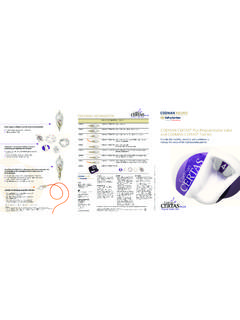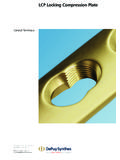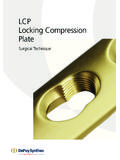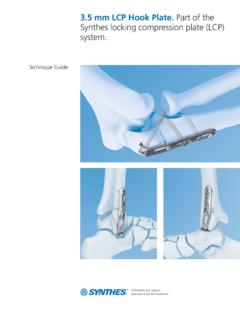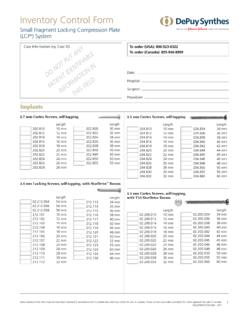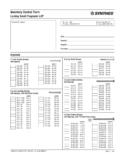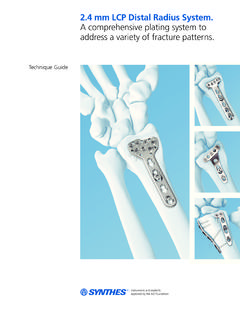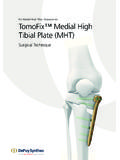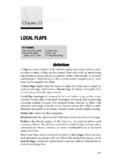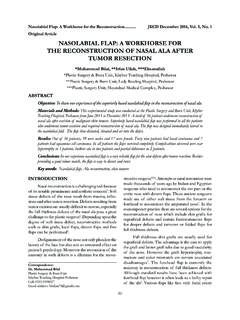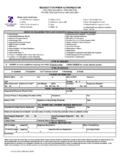Transcription of XCM Biologic Tissue Matrix. Regenerative matrix for ...
1 XCM Biologic Tissue matrix for reinforcementand repair of soft ,ready-to-useAllows for cellularinfiltrationStrength withoutcrosslinking Synthes 1 XCM Biologic Tissue MatrixXCM Biologic Tissue matrix is a sterile non-cross-linked 3-D matrix derived from porcine dermis. Dermis is composedof cells and extracellular matrix (ECM), a combination of proteins, proteoglycans, glycosaminoglycans, and other biological materials produced by cells that form the struc-tures of all the tissues in the Biologic Tissue matrix is manufactured by Kensey NashCorporation and available through Synthes Biologic Tissue matrix undergoes Kensey Nash s proprietary Optrix process, which has been developed tobe strong enough to disinfect the Tissue , inactivate viruses,and remove the cells, yet gentle enough to maintain the bulkof the natural ECM components and minimize damage tothe Tissue result is a strong Biologic implant with the propertiesneeded to facilitate soft Tissue healing.
2 XCM Biologic TissueMatrix is ready-to-use, right out of the package. No hydrat-ing or rinsing is required. Once the Tissue matrix is implanted,it provides a structure that can be infiltrated by the body cross section of XCM Biologic Tissue matrix (500 magnification)2 Synthes XCM Biologic Tissue MatrixFeaturesXCM Biologic Tissue matrix provides reinforcement and repair of soft tissueduring healing. Hydrated and ready-to-useout of the package Structurally allows for cellular infiltration Strength without crosslinking Can be stored at room temperature No risk of human disease transmission No prestretching required Large sizes available Consistent thickness No orientation required Terminally sterilizedHyaluronanGlycoproteinElastinC ollagen Synthes 3 Clinical applicationsClinical applications include, but arenot limited to the following.
3 Hernia repair Defects of the thoracic wall Suture line reinforcement Muscle flap reinforcement Plastic and reconstructive procedures Breast reconstruction Abdominal wall reconstruction Orofacial reconstructive proceduresFibroblasts growing into XCM Biologic Tissue Matrixafter 7 days in culture. Immunohistochemical stainingof intracellular actin filaments (red) and nuclei (blue)show excellent attachment (200 magnification)++Immunohistochemical stains courtesy of VacantiLaboratory for Tissue Engineering and OrganFabrication, Massachusetts General HospitalProteoglycan Molecule4 Synthes XCM Biologic Tissue MatrixIndications and ContraindicationsIndicationsXCM Biologic Tissue matrix is indicated for use in generalsurgical procedures for the reinforcement and repair of softtissue where weakness exists including, but not limited to;defects of the thoracic wall, suture line reinforcement , andmuscle flap reinforcement ; hernia repair.
4 Soft Tissue recon-structive procedures including but not limited to plastic andreconstructive surgical applications such as breast reconstruc-tion, abdominal wall reconstruction, and orofacial recon-structive procedures; and for reinforcement of the soft tis-sues, which are repaired by suture or suture anchors. XCMB iologic Tissue matrix is intended for one time device is derived from a porcine source and should notbe used for patients with known sensitivity to porcine mate-rial. The device is contraindicated for patients known to beundergoing desensitization injections to meat products, asthese injections can contain porcine wall XCM Biologic Tissue matrix placement options for abdominalwall reconstruction and hernia OnlayB InlayC SublayD UnderlayE Intraperitoneal Synthes 5 Device PropertiesBiomechanical TestingXCM Biologic Tissue matrix has been subjected to biome-chanical testing to characterize its physical testing was conducted according to internationallyrecognized standard procedures, which subjects a dogbone-shaped sample to tensile forces at 50 mm per minute andmeasures the maximum tensile force.
5 * All forces are normal-ized to the width of the dogbone. XCM Biologic Tissue Ma-trix demonstrates an average tensile strength of 130 N/cm,greater than leading products made from PTFE, heavyweightmacroporous polypropylene, and midweight macroporousprolene/cellulose/PDS, and well in excess of normal human was conducted to determine the ability of the tissuematrix to withstand suture pull-out forces. A #2 suture wasplaced 2 mm from the edge of the device. XCM Biologic Tis-sue matrix demonstrates a suture retention strength of 54 N,far in excess of PTFE and midweight macroporous prolene/cellulose/PDS.* Data on file at Kensey Nash Corporation140120100806040200 Tensile strengthNative Fascia strength=16 N /cmN/cmXCM BiologicMatrixComposite Prolene / PDSP-propylene PTFE 6050403020100 Suture pull-out strengthNXCM BiologicMatrixComposite Prolene / PDSPTFE 6 Synthes XCM Biologic Tissue MatrixKensey Nash Corporation s OptrixCleansing ProcessHematoxylin and eosin image of XCM Biologic Tissue matrix (bottom).
6 Note cells(dark blue) in raw material (top), and no cells and preservation of naturalarchitecture in XCM Biologic Tissue matrix . Results of Pico Green testing measuring the amount of DNA in a test Biologic Tissue matrix is reduced to background levels of residual DNA.* Data on file at Kensey Nash CorporationKensey Nash is a Regenerative medicine company with morethan 20 years of experience in processing Biologic Nash has drawn from this experience to develop theOptrix cleansing process. This Tissue cleansing process re-moves antigenic components from Biologic materials whilemaintaining the native collagen structure and key extracellu-lar matrix molecules used in Tissue resultis a strong, acellular Biologic graft that facilitates soft tissuehealing.*Key features of the Optrix process used in the manufacturingof XCM Biologic Tissue matrix include.
7 * Removal of cells and DNA Inactivation and clearance of viruses Maintenance of intact collagen structure for excellentstrength and durability without crosslinking Preservation of natural fibrous architecture that providesa scaffold for cell in-growth and proliferation Retention of beneficial extracellular matrix molecules resulting in a scaffold that allows revascularizationand Tissue regeneration120010008006004002000 DNA Measured by Pico Greenng DNA / mgXCM BiologicMatrixRawDermisPorcineSiSDeviceH umanDermisDevice Synthes 7 Histological ProfilesImmunohistochemical evaluation of XCM Biologic Tissue Ma-trix confirms that the major components of the extracellularmatrix are preserved after processing.
8 +XCM Biologic Tissue matrix was evaluated for proteins suchas collagen. Collagen is the most abundant structural proteinfound in mammals and plays an important role in Tissue organization and biomechanical immuno-histochemical assays, various collagen types have beenconfirmed to be present in XCM Biologic Tissue matrix including types 1, 3, 4 and 7 collagen.*+Types 1 and 3 collagens are produced by fibroblasts and are the essentialstructural elements of most soft 4 and 7 collagens provide attachment sites for epithelial, endothelial,and mesothelial of the natural collagenarchitecture as demonstrated in the XCM Biologic Tissue Ma-trix is an important property of Tissue regeneration presence of elastin was confirmed through Van is another important structural protein required for proper biomechanical function of various elastin is degraded, its fragments become matrikines which are chemotactic for numerous cell staining in raw dermis (top) and XCM Biologic Tissue matrix (bottom).
9 Purple staining indicates cells and red staining indicates the presence ofhyaluronic acid.+* Data on file at Kensey Nash Corporation+Immunohistochemical stains courtesy of Vacanti Laboratory for TissueEngineering and Organ Fabrication, Massachusetts General Hospital8 Synthes XCM Biologic Tissue MatrixImmunohistochemistry was used to confirm the presenceof glycoproteins such as fibronectin and laminin.+2Fi-bronectin plays a vital role in cell adhesion, cell differentia-tion, and is highly involved in Tissue an important molecule for the adhesion of epithelial, en-dothelial, and mesothelial cells, and a key factor in blue staining and spectrophotometric analysis byBlyscan assay confirmed the presence of sulfated gly-cosaminoglycans (GAG). Immunohistochemistry confirmedthe presence of non-sulfated GAGs (hyaluronic acid).
10 +*GAGs are highly charged molecules that are important forcell-cell signaling and cell- matrix interaction. GAGs sequesterwater for structural support and play important roles in theregulation of many Tissue functions, such as Tissue staining in raw dermis (top) and XCM Biologic Tissue matrix (bottom). Blue staining indicates cells and green staining indicates fibronectin.+* Data on file at Kensey Nash Corporation+Immunohistochemical stains courtesy of Vacanti Laboratory for Tissue Engineering and Organ Fabrication, Massachusetts General HospitalHistological ProfilesA 4 4 cm window defect was createdin sheep fascia lata and abdominal wallfascia and repaired with XCM BiologicTissue matrix . After 6 and 12 weeks,the implant sites were harvested andsubjected to mechanical testing andhistological implant sites appeared to be wellintegrated with the surrounding tissueat both 6 and 12 weeks.
